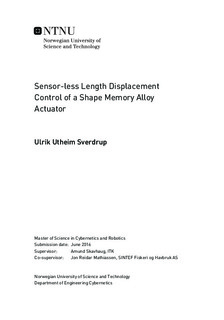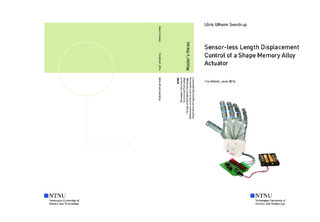| dc.description.abstract | Motivated by designing a robotic gripper actuated by a Shape Memory Alloy actuator wire, this thesis investigates the possibility of designing a sensor-less length displacement controller by utilizing the inherent self-sensing ability of the wire. Where sensor-less means no external sensors. Based on work done by Liu et al. (2009), Dutta and Ghorbel (2005) and others in the field, the thesis further discusses the process of implementing the controller in a robotic hand or a gripper on an end effector of a robot arm.
Estimates based on step response measurement data were fitted with polynomial functions derived by least squares method both to compensate for poor measurement due to a fault in the circuit, and for estimating the displacement. The tests showed that the relation between the displacement and the electric resistance in the wire was close to linear in the contraction phase. Thus, a function was fitted to serve as an estimator of the displacement dependent on the calculated resistance. This estimate is then used as the feedback for the control loop.
Despite the poor performance of the estimator, the fast dynamics of the PID controller compensated for some of the violent and rapid perturbations, resulting in a tracking capability with relatively large error of the set point, but still tracking the set point to some extent. Further, the thesis discusses the applicability of the solution combined with a tactile sensor feedback despite the low accuracy of the estimator. Implementing a tactile sensor reduces the requirements with regards to accuracy because when the tactile sensor register a change in value it means the wire has contracted far enough. Thus, drawing the conclusion that the applicability is highly probable.
For future work with the system, the measurement must be improved. This thesis discusses the possible solution of designing a program which uses a soft PWM to ensure that the analog read is timed when the PWM
signal is high. This removes the unwanted bias of the amplification and simplifies the circuit significantly. | |

